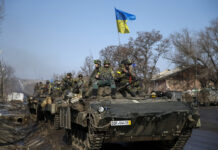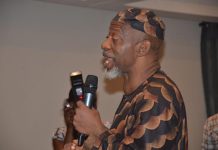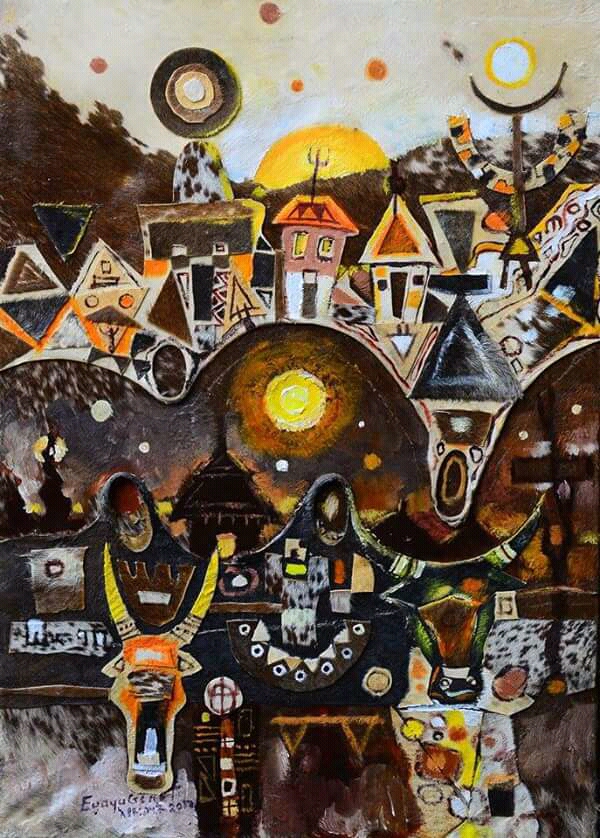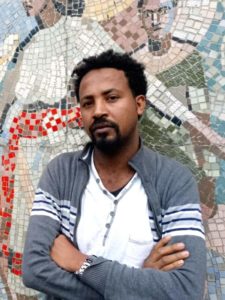 This writer cannot but start by narrating his first encounter with Eyayu Genet’s painting. It was an encounter of a colourful and intense communication.
This writer cannot but start by narrating his first encounter with Eyayu Genet’s painting. It was an encounter of a colourful and intense communication.
On this day, I went through my notifications, my messages and back to my timeline. While scrolling through my timeline, a frame of colours hit my retina with a forceful iridescence that made me pause for minutes; I had stumbled on a painting. I later saved the painting for subsequent examination and appreciation.
Reading into its iconography was strenuous but the formal analysis of the painting wouldn’t let you give up on it. The dominant form in the painting occupies the right side of the frame and the only vivid image I could see is an image of a head of a cow whose horns reaches to the sky. There is a house at the left-foreground of the painting that stands apart from the rest of the images and the interplay of warm and cool colours offer a perspective visage into the painting.
“In that painting, I am talking about Independence, freedom is an inborn mentality but many people lose their lives fighting for it”, was his response in a conversation that followed afterwards. “I used the small hut as a symbol of freedom from any oppressing entity”, he continued. He was so grateful that someone could spend a lot of time appreciating and examining his works.
Eyayu confided that his interest in art was initiated by a fundamental question, “Does life influence art or does art influence life”? He however explored how the tree stands in silent wisdom, whispering only when the wind calls, how the river finds its path to the ocean and how the direction of the wind remain unknown. He then found out that life and art influences each other; life influences art as art draws inspirations from life and art influences our mindset, psyche and behaviours.
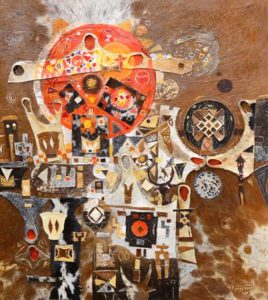
Born in Durbete, 470km north of Addis Ababa, Eyayu is of Ethiopian descent. He had his primary and secondary education in Bahir Dar and a Bachelor’s Degree in Economics from Bahir Dar University. He joined Addis Ababa University Alle School of Fine Arts and Design and received his BFA Degree in painting in 2011.
For Eyayu, art combines diverse things. He explores themes that reflect his immediate environment and borrow motifs from ancient and modern Ethiopia to create a harmonious environment between the traditional and modern, as well as the barbarian and civilized. He confessed that art is an integral part of Africa and is rooted in every facet of African life.
He is determined to echo Ethiopian values and norms in his paintings. Lake Tana- the source of the Blue Nile, Ethiopia Dalol and Ras Dashen are historical landmarks and icons in Ethiopia and Eyayu metaphorically explore these to remind his people of the need to respect and protect Ethiopian traditions even in a global village where traditional norms are fading.
The constant presence of cow horn in his oeuvre is a symbol of victory. Ethiopia and Liberia are the only two countries that were never colonized in Africa; this, and Ethiopia’s decisive victory over Italy at the Battle of Adwa in 1889 where Ethiopia secured her sovereignty are the metaphors for Eyayu’s use of the cow horn as a symbol of victory.
He narrates two experiences that testify to the responses of people towards his work. The first was when a US citizen and environmental specialist bought more than seven of his paintings during his exhibition at Avanti Blue Nile Hotel (currently Blue Nile Resort) in 2015; the second was when a spectator who could not afford his works was touched by his exhibited works. He therefore gave him a 100 Ethiopian birr ($23) which Eyayu refused; the spectator became offended and told Eyayu not to undermine his gift. Eyayu apologized, and accepted his gift. These experiences motivated him to challenge himself and have opened doors for other opportunities.
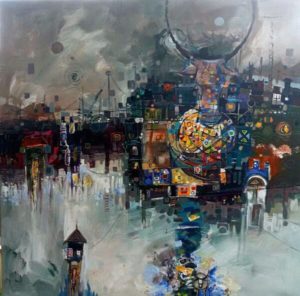
Eyayu has exhibited locally and internationally and is presently creating a melting pot of arts discourse in Ethiopia by creating a community of Ethiopian artists through the social media platform.
